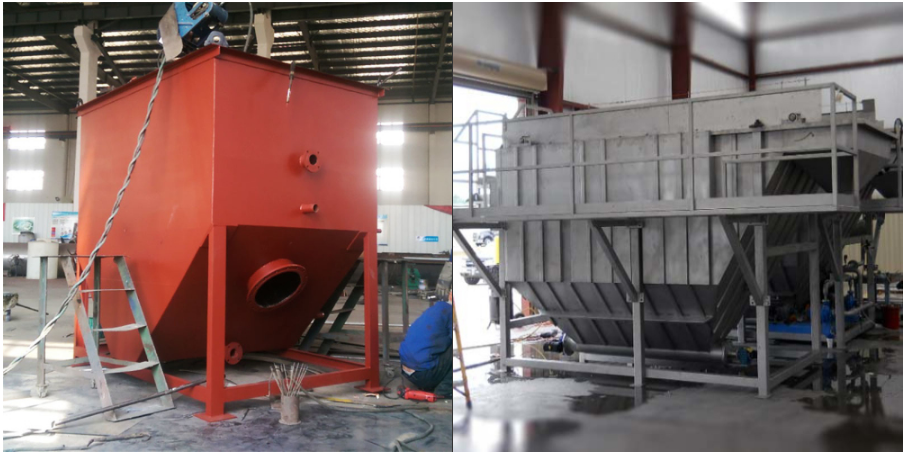The CPI separator(Corrugated Plate Interceptor Separator) is always considered as the first choice for the waste water treatment system. It provides economical and effective removal of oil and solids from waste water by gravity in a smooth, efficient automatic flow. Here are a brief introduction to the CPI oil water separator to help you better understand it.
The Theory of CPI Separator
Firstly, we will see the theory of the work of a CPI separator. CPI separators are primarily used to separate free oil from produced water or waste water or suspended solids for the water treatment in an oily water system(OWS). OWS uses the basic principle of gravity difference between the phases (liquid-liquid or solid-liquid) for the separation of the two phases. This phenomenon is described as "Gravity Separation" - that implies how a CPI oil water separator works.
Apparently, the phase with higher density will settle, while lower-density phase will float to the surface of the fluid. In an oily water system, the effectiveness of this technique, also the CPI separator, is affected by many factors, such as density difference, oil viscosity, media factors, temperature, turbulence, and the nature of impurities. Sometimes, chemical coagulation and flocculation are necessary for removal of these impurities by making them heavier. In the separation technique, the overflow rate (m3/m2/day) or sedimentation speed (m/hr) is obtained from the above factors affecting the separation of impurities. This factor determines the surface area required for gravity separation in an oily water system. By the way, this also emphasizes the point that gravity separation has nothing to do with basin depth. However, while saying so, it must be remembered that good settlement requires static conditions.
In oily water treatment, the use of tilted (placed at a predetermined angle) plate pack in a CPI oil water separator improves the size and economy of the separator system. Since the corrugated plate pack is mainly used, the tilt plate pack type separator is frequently called as a corrugated plate interceptor separator or just as a CPI separator. But a TPI can be used in a corrugated plate pack or simply a flat parallel plate pack. Therefore, TPI separator is a standard language when employed in such kind of separators. The separator, when utilized in the separation of liquid-liquid phases (mainly elimination of free oil in oily water therapy ), is referred to as a TPI or a CPI separator. Due to the gravity difference between the liquid and solid phases of the waste water, any separation of suspended solids is accidental when using TPI or CPI separators for oil water treatment.
The Feature of CPI Oil Water Separator
The corrugated plate pack in a CPI oil water separator, used for removal of free oil in a water treatment system, is made up of lots of parallel corrugated plates. A plate pack is a casing of flat plastic plates (reinforced by resins) and stiffened by a frame made from plastic substance (reinforced by resins) and/or stainless steel.
The number of plates in a plate pack is decided by different calculations and based on rich experience with various kinds of effluents and applications. The number of plates in per plate pack also depends to some extent on the economics of the size of the separator. The number of plate packs in per CPI separator is calculated based on the outflow and its characteristics to the equipment. The liquid to be processed flows through the space between the corrugated plates in each plate pack. In a CPI oil water separator, an ideal separation condition can be achieved by simulating laminar flow conditions through the plate pack.
In order to minimize the frictional resistance between the corrugated plates and the separated materials, special attention has to be paid to the smoothness and hardness of the surface of plates. The corrugated plates, as well as the casing of plate pack of a CPI separator, are usually made from glass fiber reinforced polyester resin. This material has better resistance to the most commonly used chemical additives, temperatures, and the waste water to be treated.

Advantages & Disadvantages of CPI Oil Water Separator
The CPI oil water separator is widely used in many water treatment systems due to its advantages. Here are some of them.
Advantages
- Low requirement for spare parts;
- Really low maintenance cost as there aren’t any moving parts;
- High efficacy and capacity together with compact volume;
- Can handle shock loads of flow without significantly affecting effluent quality;
- Many different kinds of basins (RCC, Mild Steel, Stainless Steel) can be chosen for plate packs in a CPI separator.
Nothing is perfect. The CPI oil water separator still has some disadvantages.
Disadvantages
- The effluent oil concentration is significantly greater than that of other processes;
- A large surface area is required;
- Enormous volume results in dead zones and loss of net available surface area;
- Ineffective with little oil droplets or emulsified oil;
- Extended retention period is needed to achieve efficient separation;
- Expensive oil/bottom scrapers & intensive upkeep are required.
These are our brief introduction to a CPI oil water separator. If you have any questions about it, please contact us without any hesitation. Our knowledgeable experts are always ready to answer your questions!

